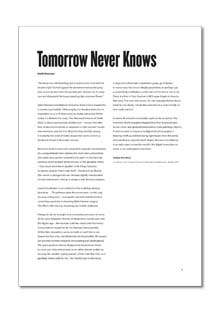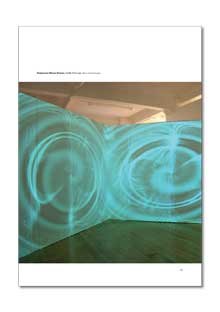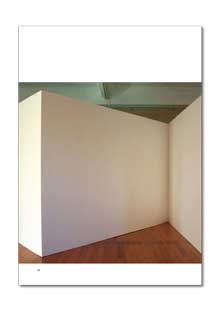 |
|||||||||
|
|
| ...Publications: Annual | ...Tomorrow Never Knows. | ||||||||||||
|
Tomorrow Never Knows. ‘The house was still throbbing, but a moment later it locked and became rigid. I leaned against the demented wall and let spray pour across my face from the sprinkler jets. Around me, its wings torn and disarrayed, the house reared up like a tortured flower.’ 1 Stella Brennan’s installation Tomorrow Never Knows (named for a sweetly psychedelic 1966 song by the Beatles) draws for its inspiration on a sci-fi short story by darkly subversive British writer J. G. Ballard. The story, ‘The Thousand Dreams of Stella Vista’, is about psychotropic architecture - houses that alter their entire environments in response to their owners’ moods and emotions, only for it to all go horribly, horribly wrong. It is exactly this kind of failed utopia that seems to form a dominant thread in Brennan’s oeuvre. Brennan’s work incorporates projected computer visualisations of a computerised voice reading the short story, polystyrene slab walls, story quotes scratched into paint on blacked-out windows and a “potted” photo-history of the geodesic dome - that visual-short-hand signifier of all things futuristic. As always, utopian vision eats itself - freedom is an illusion. The viewer is plunged into an intimate, tightly manipulated virtual environment. Vertigo is always a risk. Brennan explains: Sound visualisation is an evolution of the bubbling, glowing lava lamp … The software takes the sound wave - in this case, the story-telling voice - and applies real-time transformations, converting sound into a streaming field of stoner imagery. The effect is like moving, morphing, psychedelic wallpaper. Perhaps it can be thought of as a knowing evocation of some of the more Romantic themes of Modernism carried over into the digital age - the Burkean Sublime mixed with the heroic transcendence hoped for by the Abstract Expressionists. All the New Jerusalems we try to build on earth fail or are flawed: the Romantic, the Modernist, the Psychedelic. All utopias are doomed by their solipsistic lotus-eating and navel-gazing. The giant geodesic domes designed by Buckminster Fuller to cover our cities and protect us on other planets ended up housing the satellite spying stations of the Cold War. One such geodesic dome, built for the 1967 World Expo in Montreal, is depicted in Brennan’s installation going up in flames. In many ways the tone is deeply pessimistic, or perhaps just a melancholy meditation on the ruins of the future not to be. There is a line in Tony Kushner's AIDS opus Angels In America that runs: ‘The man who wrote The Star Spangled Banner knew what he was doing. He set the word free to a note so high no one could reach it.’ It seems all artworks eventually aspire to be sculpture. The invention of photography triggered the Post-Impressionists to use colour and gestural brushwork to make paintings objects. A century later in response to digital art, photography is blowing itself up and borrowing light-boxes from the arena of marketing to objectify itself. Maybe Brennan’s installation is an early step in a similar trend in the digital in reaction to some as yet unimagined transition. Andrew Paul Wood 1 J. G. Ballard,‘The Thousand Dreams of Stella Vista’, Vermilion Sands, Berkley, 1971 View Tomorrow Never Knows. Essay by Andrew Paul Wood as a PDF This essay originally appeared in The Physics Room Annual 2004 Order your copy today from The Physics Room ! Related 6 - 29 May, 2004
|
||||||||||||



